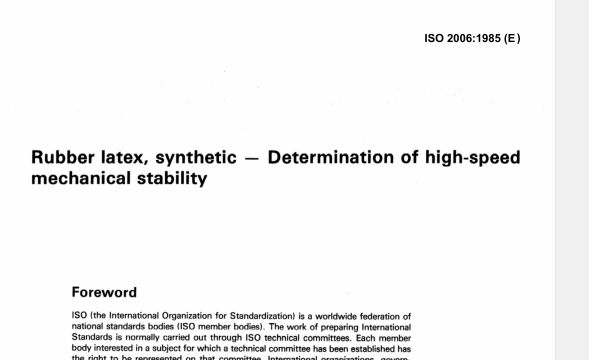DIN ISO 2006 pdf download – Rubber latex, synthetic – Determination of high-speed mechanical stability.
3 Principle
A test portion is stirred at high speed.
The amount of coagulum formed is regarded as an inverse
measure of the mechanical stability of the latex.
4 Reagent
During the analysis. use only distilled water or water of equivalent purity.
Soap solution, 5 % (rn/rn) solution of potassium oleate of pH value 10, or, for use with a latex which is coagulated by potassium oleate solution. 5 % (rn/rn) solution of a synthetic anionic or non-ionic surfactant.
5 Apparatus
Ordinary laboratory apparatus and
5.1 M.chanical stability measuring apparatus21, consasting of the following items:
5.1.1 Latex container, flat-bottomed, cylindrical, at least
100 mm high, with an internal diameter of 58 ± 2 mm and a wall thickness of about 2.5 mm. The inner surface shafl be smooth, and a glass container is preferred.
5.12 StIrling apparatus, consisting of a vertical stainless steel shaft of sufficient length to reach to the bottom of the latex container (5.1.1) and tapering to approximatety 6,3 mm diameter at its lower end, where is attached a horizontal. smooth, stainless steel disk 36,12 ± 0,03 mm in diameter and 1.57 ± 0,06 mm thick by means of a threaded stud at the exact centre of the disk. The apparatus shal maintain stirring at a rotational frequency of 14 000 ± 200 mm 11233 ± 3 s 1)3) throughout the test, at which frequency the shaft shall not run out of the true by more than 0,25 mm.
5.2 Preliminary filter, of stainless steel were cloth with an average aperture width of 180 ± 15 pm.
5.3 Test filter, consisting of a disk of stainless steel wire cloth with an verae dpertu’e width of 180 ± 15 pm, dried to constant mass and weighed to the nearest I mg, firmly damped between two stainless steel rings of equal internal diameter between 25 and 50 mm.
6 Sampling
Carry out the sampling in accordance with one of the methods specified in ISO 123.
7 Procedure
If the total solids content of the latex is not known. detemiine It in accordance with ISO 124.
It the viscosity of the latex determined with the L instrument (according to ISO 16521 exceeds 200 mPas (200 cP), dilute It to this or a lower value, with en amount of water which reduces the concentration of the latex by not more than 10 % (rn/rn) total solids.
Adjust the temperature of the latex to 25 ± 3 °C. pass it through the preliminary filter (5.21 and transfer 50 ± 0.5 g to the latex container (5.1.1.
Piece the container in position, and stir the latex, ensuring that the rotational frequency of the stirrer (5.1.21 is 14 000 ± 200 mm – (233 ± 3 g 1) for the agreed time, between 1 and 30 mm, and of such duration that the latex does not increase in temperature to more than 60 °C and does not exceed a height of 100 mm in the container, it it is necessary to limit foaming, a paste of a silicone dat namer shall be smeared around the upper portion of the inner surface of the container.
Immediately after the termination of stirring, remove the latex container and wash the stirrer shaft and disk free from latex deposits with the soap solution (clause 41. Wet the test filter (5.3) wIth the soap solution and pour the latex and washings into the test filter. Use the soap solution to ensure quantitative transfer of all latex and deposits including skin. Wash the residue on the test filter with the soap solution until it Is free from latex and then with water unt the washings are neutral to litmus. Carefully remove the test filter containing the wet solid matter and swab the underside with filter paper. Dry the test filter and coegulum at 100 ± 5 °C until the change in mass is less than 1 mg after 15 mm drying.
DIN ISO 2006 pdf download – Rubber latex, synthetic – Determination of high-speed mechanical stability
